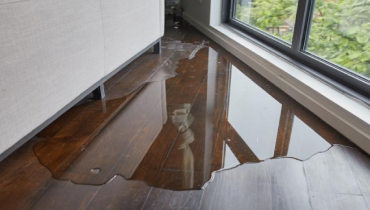
Water-damaged wood floors require careful restoration to prevent further harm. Rainbow Restoration highlights these common mistakes to avoid:
|
Wood flooring is beautiful and can be an important asset to your home. Most of the time, it offers excellent durability, easy care, and will continue to look attractive for many years. However, wood floors are more vulnerable to water damage than many other types of floor coverings. How you treat your wood floors after a leak or flood will determine whether they can be repaired, or if they must be replaced.
Unfortunately, it’s all too easy to overlook important steps that can keep you on the “save and repair” path, so let’s go over some things you should not do when dealing with water-damaged wood floors.
Failing to Contact Your Insurance Company
Before starting any type of cleaning or repair, contact your insurance company to find out if cleanup and remediation are covered by your policy. It’s hard to know what is and isn’t covered until you speak with your insurance company, so bring them in as soon as you can. Also, be sure you’re contacting the right insurance agency for your type of water damage. If the water came from inside your home (like a busted pipe) it will likely be covered by your homeowners’ policy. But if the water came from outside your home (like a flood) it may only be covered if you have separate flood insurance. Contacting your insurance company early in the process will help them provide guidance to get you moving in the right direction.
Using Your Home Vacuum
Once you’ve spoken to your insurance company, the cleanup can begin. Your first step usually involves removing the water. While most home vacuum cleaners work fine for cleaning up dry materials, they’re completely unsuited for wet materials. To remove water from your floors, it’s important to use a shop vac or a wet/dry vac in the wet mode. Unlike a regular vacuum, a shop vac uses no filter and no bag. It sucks up the water right into a bin, which can be emptied once it fills up. You can buy or rent a shop vac similar to the ones the professionals use at your local home improvement store.
Adding Heat to Dry Quickly
After most of the water has been removed, it’s time to dry the floor. Drying a wet wood floor can be tricky. Factors such as the relative humidity in the air and the type of subfloor can have a major impact on the drying process. As a result, it can take time for the wood to dry completely. It might seem logical to apply heat to encourage the floor to dry out faster but adding heat can also cause wood to dry too quickly, resulting in warping and rapid shrinking. However, a floor that dries too slowly is at a greater risk of developing mold—which is definitely not a DIY cleanup. Since mold can develop quickly and without warning, it’s important to get the floor dried as quickly as possible, without doing permanent damage. The experts at Rainbow Restoration use a comprehensive process for quick drying the floor that minimizes the risk of damage and helps prevent the development of mold.
Forgetting to Check All Surfaces for Water Damage
Since your wood floor is on the surface and the most visible, it’s easy to forget other places that might be affected by moisture. When looking for additional damage, be sure to check places like the subfloor. Even if it’s made from concrete and less likely to deteriorate, moisture in the subfloor can prevent your wood floor from drying properly. This moisture can be difficult to detect, which is why pros have special tools to measure moisture in different types of materials. Also, depending on how your house is built, the parts of your walls that come in contact with the flooring can also get wet. It’s important to inspect these areas to see if any water has seeped in. “Out of sight, out of mind” is not the best approach in this case.
Tackling Mold Issues by Yourself
One of the nastiest issues arising from moisture is the development of mold. Since eliminating mold can be a complicated process, you need trained professionals with the knowledge and experience to get rid of it—just missing even a small amount of mold can be enough for it to return and cause more problems. If this happens, you’ll have to deal with the problem all over again. The potential for mold development is just another reason why calling in professionals to deal with your water-damaged wood floors is a good idea.
Not Using a Professional Restoration Company
Getting water on your wood floors can be more than just a headache. It can lead to damage ranging from buckling and warping, to more serious problems like mold. And while some damage might appear right away, other damage can take days or weeks to develop. So, if plumbing leaks or severe weather cause water to affect your wood floors, it’s important to call a professional right away.
Professional Water Damage Restoration Services
The restoration professionals at Rainbow Restoration are experts when it comes to assessing water damage. They know exactly what steps to take and work with your insurance company to restore your property as quickly as possible.
Call Rainbow Restoration or schedule an appointment online for commercial and residential water damage restoration services.
